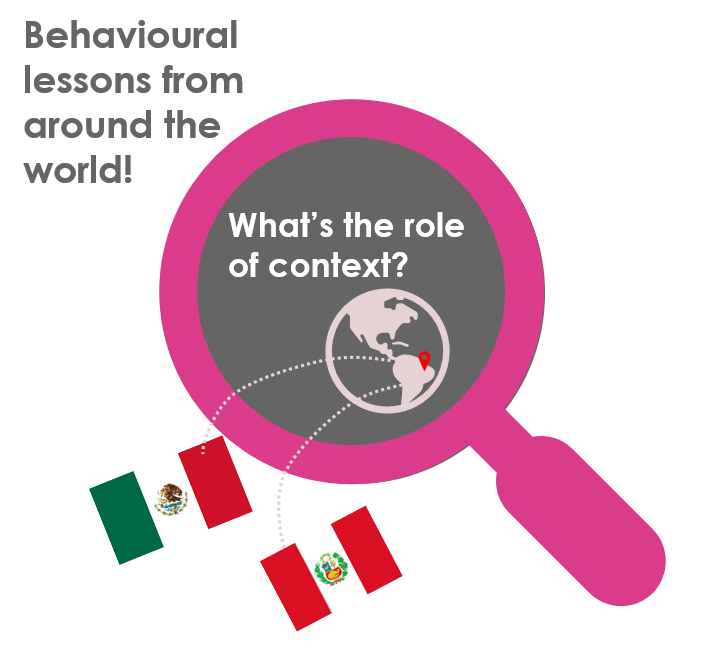Monica holds the title of Principal Advisor at The Behavioural Insights Team (BIT). From her base in London, she co-leads international programmes in over 10 countries across Africa, Europe and Latin America, including her homeland, Colombia. From anti-corruption to prevention of recidivism, teenage pregnancy to gender-based violence, as well as compliance and maternal health, Monica has experience in a wide range of policy areas.
The global experience
As someone who has managed behavioural insight (BI) interventions internationally, Monica has a big-picture view of the Global South’s BI landscape. She’s worked with governments, third-sector organisations and increasingly with smaller, local start-ups in a range of low-resource contexts.
When we asked Monica to share some of the lessons she’s learned from her time in the BI field, she begins with a wise warning: “You can never assume that something that works in one context will work in another… even if they are very similar.” You need to take each unique context into mind and be flexible enough to make necessary adjustments or creative solves. What follows are some of the notable disparities and similarities Monica and her team found while working across different continents.
The BIT methodology
During the first phase, or ‘Target’ phase, the team would usually scope out and identify a broad policy challenge that is a priority for local partners. They then delve down into specific behaviours, brainstorming, and researching how behavioural science could assist in this space. This is where BI literature and quantitative data play an important role - finding measurable behavioural outcomes that contribute to the problem.
The second phase is referred to as the ‘Explore’ phase. This in-depth qualitative phase involves going into the context to try to fully understand the conditions and perspective of the end-user, or whoever the policy is being designed for. This step is even more crucial in low-resource contexts. “We try and understand their motivators, the barriers, and where the bottlenecks might be,” says Monica.
“Through this process, you also identify structural barriers that you wouldn’t have been able to anticipate without coming into the context.”
Infrastructure challenges in Peru
Monica gives us a more specific example: “We were working on a project with the World Bank in Peru, trying to increase teacher attendance and motivation in schools, and we wanted to test something that we could place in the classroom to remind the teachers of the impact that they were having on the children.” They first collected qualitative data in Lima, the capital city, which was no problem. “We then decided to go into rural areas to get qualitative information, and we noticed that some schools didn't have such infrastructure. They didn’t have walls or typical classrooms.” Instead, children took classes outside and were also mixed at different levels.
“We quickly realised that the intervention we had planned was not feasible in this space and we'd have to adapt.”
Data challenges in Mexico
“An additional challenge that we face in some of the low-income contexts is that data is still a very manual or disconnected process,” explains Monica. For example, in Mexico when working with the Inter-American Development Bank, BIT aimed to get more employers to register their employees for social security but were struggling to get unregistered employee figures. At the same time, they happened to be working on another intervention with the Mexican tax authority. "We realised that employers had to declare their employees for tax purposes,” she says, “so we cross-referenced and merged the databases from social security and the tax authority to see which employers did not register their employees for the social security scheme.”
Cross-referencing is not necessarily a novel approach, but the way in which BIT got government agencies to work together is to be commended. The takeaway: if you can, talk to your government partners and try to foster more data sharing and collaboration. By connecting and bridging agencies together, you can often benefit both parties and get better results for the beneficiary, too.
Application in Africa
In the past few years, BIT has seen a boom of projects in Africa, mostly concentrating on East Africa, plus a few in Southern and West Africa, with a strong focus on corruption, health and gender-based violence (GBV). So far they found that there is little government demand for behavioural science projects, so their approach right now is to get quick wins to get more local buy-in and work with third sector organisations and local NGOs.
Lessons from the Global South
In developing countries, Monica sees multiple opportunities to continue pushing the boundaries of where behavioural science can be applied and rigorously tested as policy areas tend to be more complex: issues such as GBV, humanitarian efforts, and social cohesion, for example.
Overall, Monica and her team found that across Latin America in particular, BI projects tended to be more demand-driven which worked in their favour: "In Latin America, there was a wave of interest in these topics [BI work]," Monica continues,
"the type of work that we're able to do is very different when it comes as a request from a government that already knows about [BI] methodology."
It's worth noting, too, that some GBV work being done in Latin America is being used to inform BIT’s work in the UK, so the lessons can certainly be taken up-stream, so to speak.
With this kind of systemic support, BIT found that they were able to target larger policy challenges in a generally smoother process. What we can take away from this is that an increase in BI literacy within government structures can increase effectivity in BI work across the board.


